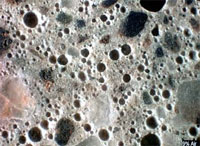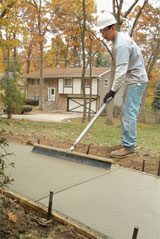
Used in many applications, air-entrained concrete uses a chemical admixture (or sometimes, air-entraining cement) to produce a system of small voids during the mixing process. These voids are stabilized by the air-entraining admixture and remain in the hardened concrete paste. The primary use of air-entraining concrete is for freeze-thaw resistance. The air voids provide pressure relief sites during a freeze event, allowing the water inside the concrete to freeze without inducing large internal stresses. Another related use is for deicer-scaling resistance. The air voids again provide relief sites for the buildup of salt concentrations and the pressures that result due to concentration gradients. Other uses of air-entrained concrete include sulfate resistance, resistance to alkali-silica reactivity, and improved workability.
Hard troweling is a process by which a finisher uses a steel trowel to densify the surface of the concrete. This finish is optional and produces a hard, smooth surface. Repeated passes of steel troweling will result in a burnished finish, which has a mirror-like appearance. Hard-troweled surfaces are not recommended for exterior concrete slabs, because the smooth finish becomes slippery when wet.

Hard troweling is also not recommended for air-entrained concrete for several reasons. The primary reason is densification. Densification pushes air out of the surface, leading to a decrease in the air content. This increases the probability of freeze-thaw damage and deicer-scaling damage. Additionally, the densification can push the air down and rupture the voids, leading to a large void just below the surface mortar. This will cause delaminations and may cover a significant portion of the placement. Once the surface has been opened, through scaling or delamination, the densified surface gained through hard troweling is lost.